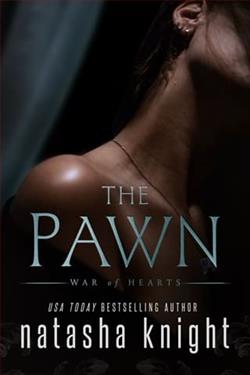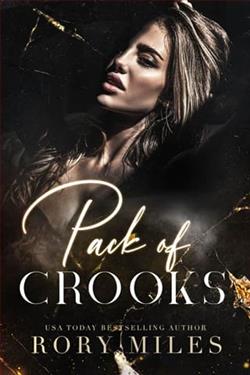Page 37 of The Scene of the Crime
‘Glow sticks, like luminol, are based on chemical reactions that produce light, known as chemiluminescence. When used at a crime scene, we darken the room first and use long-exposure photography to record the blue glow, which lasts about thirty seconds.’
‘Using luminol must make your job a lot easier and speed things up,’ the detective said.
‘Yes and no. Luminol will also react to animal blood, bleaching agents and other oxidising compounds, such as those found in urine or saliva, so a positive luminol test doesn’t necessarily confirm human blood. We still have to take samples and do more specific tests at the lab to identify human blood suitable for DNA testing.’
Jessica played the video showing the garden’s exterior and side gate entrance, explaining the intruder’s entry route from Homer Road. ‘We believe the intruder climbed onto the neighbour’s low wall and gate, then up onto the De Klerks’ wall, and lowered himself onto the raised bedding area, where he left a shoe print.’
‘He must be pretty fit to have climbed up and over a wall as high as that,’ an older detective commented.
Jessica agreed and had more to add. ‘Taff Jones believes a right-hand glove mark on top of the neighbour’s metal gate may be of evidential value.’ Some team members looked puzzled, and a detective questioned how a glove mark could be helpful. Jessica brought up photographs of the glove prints. ‘Woollen gloves can leave fibres behind. But in this case, Taff suspects the marks were left by touchscreen gloves that allow the wearer to use smartphones and tablets when wearing them.’ Jessica explained that different kinds of conductive material are woven into the fingertips and thumb of touchscreen gloves. She said it was usually copper yarn, but some glove makers use aluminium or thermal paste. ‘The marks from the palm were consistent with a decorative stitched silicone pattern that could be unique to the glove, though, with wear and tear, the original pattern of the touch screen fingers and silicone changes, and the more they are used, the more the pattern will alter from the one left at the crime scene.’
‘Is it the same principle with shoe marks?’ DC Owens asked.
Jessica nodded. ‘We will do further research on the silicone pattern to identify the make of the glove and suppliers. We know a jemmy, or something similar, was used to force open the patio door and the safe, but from the striation marks, it appears a different implement was used on each.’
‘Does that mean there were two intruders?’ another detective asked.
‘The footmarks and other evidence we recovered indicate a lone intruder, but I can’t rule out more than one person was involved. We also believe he may have used a rucksack or other kind of bag to carry a jemmy or other tools to break open the safe. If he put the rucksack down on the carpet, there may be fibres from it on the carpet or soil if he put it down outside.’
Chapman stepped forward. ‘When we identify a suspect, we obviously need to do a thorough search for the items Jessica has just mentioned.’
A detective asked if they knew what was stolen from the safe. Jessica said Mrs De Klerk didn’t know what her husband kept in it, and only Johan could answer that question, if and when he recovered from his injuries. Next, she informed them about the disturbance in the living room relating to the coffee table and items that could have fallen from it during a struggle between De Klerk and his assailant.
‘Taff examined the carpet and floor leading from the living room to a knife block in the kitchen. He found barefoot marks, which we believe to be Mr De Klerk’s and on top of some of them were the Adidas imprints. This infers that at some point during the struggle in the living room, Mr De Klerk moved towards the knife block in the kitchen, followed by his attacker.’ She brought up the photos of the area one by one.
‘Jesus, it’s a bloodbath,’ someone commented, and Jessica noticed a pale-looking Dawn put her hand to her mouth as ifshe was about to be sick. Jessica leaned towards Chapman and spoke quietly.
‘As you assisted Diane, would you like to explain her blood pattern analysis and interpretation to the team? I’ll project the close-up photos as you speak.’
He looked pleased as he removed his pocketbook from his jacket. ‘I made notes, so I’ll give it a go, but tell me if I go wrong.’ Chapman spoke slowly as he repeated everything Diane said about the blood distribution in the kitchen and the likely course of events. Then, using the photographs of the bloodstains, pooling and knife block, he described De Klerk’s movements and how he was repeatedly stabbed with one of his own household knives, which was embedded in his back before the assailant stepped in the blood and then left the house.
The team listened in silence, amazed yet appalled, as Chapman detailed the ferocity of the attack. He added that if it hadn’t been for the quick attendance of the paramedics, De Klerk would have undoubtedly died at the scene. When he finished, he looked at Jessica, wondering if he’d explained everything correctly.
She nodded her approval. Jessica continued. ‘Diane didn’t find any blood droplets from the kitchen to the hallway, suggesting the assailant hadn’t received an injury that bled. However, he could still have been scratched, bruised or injured in some way.’
Jessica displayed some of the electrostatic footprint lifts on the TV screen. ‘These shoe prints were recovered in the living room by the ransacked drawers and the basement study. As you can see, the tread mark is the same as the other suspect marks. No traces of blood were found in them, which implies the drawers and safe were opened before Mr De Klerk was beaten and stabbed.’
‘Do we know if anything was stolen from the living room?’ DC Owens asked.
‘Not at present, but the opening of the drawers and scattering of some of the contents may have been staged. Only the top drawers had their contents removed and thrown around the floor . . . the other drawers were open but undisturbed.’
‘I don’t get how that’s staged,’ the young detective queried.
‘I would have expected a burglar searching for hidden cash or items of value to look in all the drawers and even go upstairs to look for jewellery. He didn’t, which suggests the intruder already knew the location of the safe and maybe the contents but staged the living room to cover the fact. I can’t say specifically what woke Mr De Klerk or made him go downstairs. I should also add that Mr De Klerk was due to be in Lancashire over the weekend at a christening with his wife, but he pulled out at the last minute due to a problem with his wine importation business.’
‘So, whoever broke in might have thought he was away,’ a detective observed, and Jessica nodded. Other detectives started chipping in with their opinions. One thought it odd that if De Klerk had his phone upstairs and heard a noise, he didn’t call the police immediately and lock himself in the bathroom. Another said that when De Klerk went downstairs, he’d have to go through the living room to get to the kitchen, and if the intruder was in there, De Klerk would have seen him. This led to an officer remarking that the intruder could have hidden behind the sofa if he had heard De Klerk coming downstairs or been in the basement breaking into the safe.
Jessica had considered all these things, but she wanted the team to be involved and come up with their own ideas, no matter how implausible they might be. Challenging each other’s opinions was a good thing.
Chapman raised his hand. ‘Enough conjecture.’ He looked at Dawn. ‘Make sure you ask Mrs De Klerk if they haverecently employed any cleaners, handymen or builders and get their details. The property was recently refurbished, and the contractors should all be questioned too. I’m not saying they might be directly involved, but they would know the house’s layout.’ There were nods and grunts of assent around the room. Jessica could see that Chapman liked being the boss in Anderson’s absence, and the team respected him.
A dour-looking detective sergeant – Julian Wood, aged forty-eight and the eldest and most experienced detective – who had so far remained silent, finally spoke up. ‘I don’t wish to appear rude, and I don’t disagree with your scene analysis . . . but all we have so far is conjecture about what might or might not have happened. There don’t appear to be any forensic leads that might help us directly identify the person responsible.’
‘We recovered two items, one of which might help to do that, or at least trace someone worth speaking to . . .’ Jessica paused to bring up a photograph. She showed the team photos of the animal-engraved crystal glasses and told them where she found them. She added that both glasses still had some wet residue in them. ‘I am not a drinks connoisseur, but the smell of what was left in each glass was different, possibly a spirit of some kind. It made me wonder if De Klerk was drinking with someone in the cinema room recently, maybe even last night before he was attacked. We will check the glasses for fingerprints and DNA. If there’s saliva on the glass, we can also identify it as male or female. We will run any recovered fingerprints through the database as soon as possible and hopefully have a result for you sometime tomorrow. The DNA work will take a day or two, maybe longer, depending on the quality of it,’ she said, closing her iPad. The team looked at Jessica with new respect, as this could be a significant breakthrough early in the investigation.
‘You certainly like to keep the best for last,’ Chapman said, grinning. ‘I think we’ve covered everything for now unless there’s anything else you want to ask us?’
DS Wood raised his hand. ‘DCI Anderson seems convinced this is a burglary gone wrong. From what you’ve just told us, that may not be the case?’















